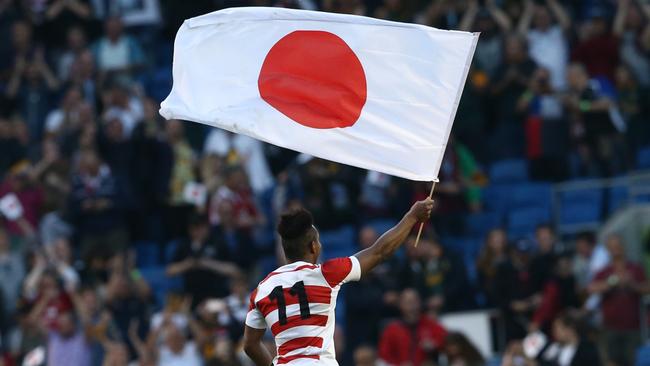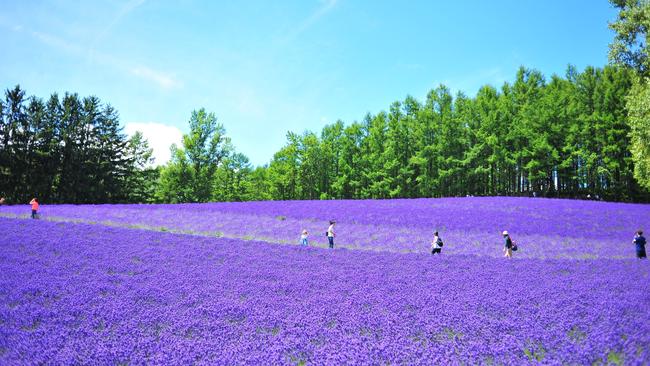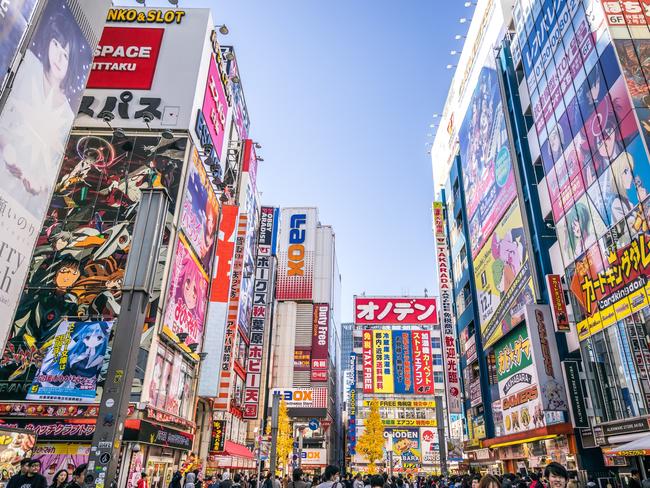World Cup 2019: Game on in Japan
Lucky enough to be heading to the rugby? Here’s everything you need to know about what to do and where to go when not watching the Wallabies.

Japan is a relatively small country with an enviable network of super-fast trains renowned for split-second efficiency and an increasing number of low-cost airlines on domestic routes such as Jetstar Japan, Vanilla Air, Air Do, Peach Aviation and Skymark. Rugby fans attending RWC matches should expect few problems with punctuality of transport or ease of getting around. But what to do between games and how to make the most of the attractions of host cities and connecting journeys?
If you have tickets to all Pool D Wallabies qualifying games, and if the team makes it to the RWC final, that’s a period of six weeks between September 21 and November 2 and will involve repeat visits to Oita and Tokyo and travel from the northernmost to the southernmost islands. NZ All Blacks will be the team most likely to derail the Wallabies and our fans will be closely watching the New Zealanders’ expected dominance over fellow Pool B members Canada, Namibia, Italy and top contender South Africa. The 20-nation tournament will see 48 matches played at 12 venues and is expected to attract record crowds.
Go, the Wallabies
POOL D QUALIFYING MATCHES
Sapporo, Hokkaido,
September 21
Australia v Fiji, at Sapporo Dome, seats 41,410.
Getting there: Budget carrier Spring Airlines connects from Narita (Tokyo) international airport to Sapporo; flight time is about 90 minutes. In 2016, a shinkansen (bullet train) service began between Tokyo and Hakodate at the island of Hokkaido’s southern tip via tunnel; from there, connect by limited express train to Sapporo. The combined rail trip takes about eight hours and is covered by the Japan Rail Pass.

What to do: Sapporo is the capital of this island, renowned for its top-class skiing. Hokkaido is wildly beautiful, with fields of lavender to rival Provence, national parks, wildlife, hot springs and world-class dairy produce. An Hokkaido Enjoy Pass gives admission to 10 attractions in Sapporo, Lake Toya, and Hakodate areas but the most charming of all is Otaru, which can be visited on a day trip from the capital but is worth more time. Cruise the willow-shaded Otaru Canal, explore shops and cafes in converted trading stores and shop on Sakaimachi Street, pausing to sample the phenomenon known as rainbow ice cream — seven flavours whirled into towers, including melon and a delicate lavender — and what could be the world’s best cheesecake at Urato patisserie (“Otaru spelling backwards!” chirp the sales staff to foreign shoppers.)
Stay: There’s eight days before the next Pool D match in Tokyo, so why not splurge on an immersive stay at Zaborin, a superb ryokan in the Hanazono woodlands near the ski hub of Niseko. Mercure Sapporo is a reliable high-rise option in a great location, about 5km from the RWC Sapporo Dome venue. In Otaru, Unwind Hotel & Bar is immaculate; go for a superior twin or “comfort loft”.
■ unwind-amp-bar-otaru-jp.book. direct
Tokyo, September 29
Australia v Wales at Tokyo Stadium (Ajinomoto Stadium), seats 49,970.
Getting there: Tokyo is connected by air and rail with all major cities in Japan. Direct flights from Australia with Qantas, JAL, ANA and Jetstar land at Narita or Haneda airports; both international terminals have train or coach services to the metropolis.

What to do: Consider the services of an accredited Goodwill Guide for an orientation tour of Tokyo; there’s no fee for these volunteers but transport costs, any entry fees and a refreshment usually need to be covered. In advance of the RWC and next year’s Olympic Games, more and more English-speaking volunteers are on hand at stations, airports and major sites to assist visitors. Don’t miss the Akihabara electronics district, the incredible food basements of Ginza department stores such as Mitsukoshi, and the Meiji Jingu parkland near Harajuku Station with its iris gardens, walking paths and shrines. Grab a copy of the Michelin Guide Tokyo to seek out small and specialised eateries serving the city’s best noodles, sushi, tempura and yakitori.
Where to stay: Go glam at Aman Tokyo, located on the top six floors of the centrally located Otemachi Tower; Hyatt’s Andaz Tokyo Toranoman Hills is chic and stylish; and Trunk Hotel in Shibuya is for serious design aficionados.
■ jnto.org.au/questions/guide-services/
■ aman.com
Oita, October 5
Australia v Uruguay at Oita Stadium, seats 40,000.
Getting there: Oita is the capital of the prefecture of the same name, on the northeast coast of the island of Kyushu, connected by suspension bridge with Japan’s main island of Honshu. A flight from Tokyo is the easiest option; Jetstar Japan has frequent non-stop services, with flying time of one hour and 45 minutes and specials of about $100 one-way.

What to do: The city of Oita is close to Beppu, famous for its hot springs and macaque monkeys on Mount Takasaki, and faces the island of Shikoku across the Seto Inland Sea. There are forested parks, beautiful coastal drives and terraced rice fields within reach. The futuristic Oita Stadium, locally known as the Big Eye, was built for the FIFA World Cup, jointly held in Japan and South Korea in 2002. It has a retractable roof and will also host a quarter-final match between the winner of Pool D v runner-up of Pool C on October 20. The venue is about 10km from the city centre but regular shuttle buses run from the main railway station on game days. Oita is a city of about 500,000 with few notable attractions but there’s a substantially rebuilt 16th-century castle that is creatively illuminated at night to show its original contours, the heritage Yusuhara Shinto shrine, plenty of shopping in malls and specialty streets, a terrific art museum and the quiet pace of a city off the main tourist trail.
Where to stay: Hotel Shiragiku at nearby Beppu promises a “heartwarming” welcome and has its own geothermal spring and Japanese-style tatami guestrooms and standard chambers. New to Beppu is the InterContinental Beppu Resort, the first international property to open here, and just in time for RWC bookings. In this part of Kyushu, accredited minshuku (or family-run guesthouses and home stays) are also a good choice, although some basic Japanese language skills would be handy.
Shizuoka, October 11
Australia v Georgia at Shizuoka Stadium ECOPA, seats 50,889.
Getting there: Shinkansen journeys between Tokyo and Shizuoka, on Honshu Island’s south coast, take 60 or 90 minutes, depending on Hikari or Kodama express services; both are covered by the Japan Rail Pass. A comfortable coach option takes three hours.
What to do: Shizuoka Stadium ECOPA in Fukuroi City is a destination in itself, the centrepiece of the larger Ogasayama Sports Park which extends into neighbouring Kakegawa. Shizuoka, capital of the prefecture of the same name, is on Suruga Bay and is well-known for its views of Mount Fuji from pine-bordered Miho no Matsubara beach; a cable car ropeway links to Kunozan Tosho-gu, a celebrated 17th-century shrine and burial place of Tokugawa Iyeyasu (1543-1616), the founder of the last shogunate in Japan in the Tokugawa, or Edo, era. Shizuoka is a good base for regional exploration, sitting about halfway between Tokyo and Nagoya, less than two hours from the latter city by train, and within easy reach of the cultural capital of Kyoto. A side-trip to Lake Hakone and Mount Fuji from this RWC host city would also take less than two hours.
Where to stay: There’s a multitude of three and four-star hotels; Kakegawa Grand is close to ECOPA and is rated highly on aggregation sites. A lateral idea would be stay in Nagoya or Kyoto and travel to and from Fukuroi City for the match, which starts at 7.15pm. Excellent choices would be the newish Nagoya JR Gate Tower, next to the main rail terminus, and Kyoto Granbell Hotel, a very chic designer-driven property that opened in 2017 and has been consistently well reviewed. It’s affiliated with Qantas Holidays so frequent flyer points can be used and accrued.
-
More to the story
A special-edition train designed for the Rugby World Cup was unveiled in June at Kamaishi in northeast Japan’s Iwate Prefecture, one of the tournament’s 12 host destinations. The exterior designs on the carriages feature 35 local mascot characters wearing the red and white jersey stripes of Japan’s national rugby team, the Cherry Blossoms. Kamaishi, a city of about 33,000 residents, hopes to benefit from the RWC to showcase to the world its successful restoration after the 2011 earthquake and tsunami devastation. The Kamaishi Recovery Memorial Stadium will include two temporary stands, boosting numbers by 10,000 to a maximum of 16,000 spectators for Fiji v Uruguay on September 25 and Namibia v Canada on October 13. It’s the only newly built venue, and the smallest, for the RWC and stands on ground formerly occupied by an elementary school and a junior high school, both destroyed in the disaster, which claimed more than 1000 lives and destroyed about 3500 homes.
-
In the know
Buy a Japan Rail Pass before leaving Australia in modules of seven, 14 or 21 days, from $404-$823. The pre-purchased passes are much cheaper than point-to-point train tickets; railplus.com.au.
Due to the deregulation of Japan’s airline industry and increasing competition from discount carriers, domestic airfares have dropped dramatically in recent years, sometimes providing cheaper travel than shinkansen on certain routes. JAL (and oneworld colleagues) and ANA have pre-purchased air passes for exclusive use by foreign visitors to Japan, with internal sectors averaging JPY10,000 ($140); japan-guide.com.
-
On the ball
■ Tickets to matches played by the Japan national team sold out within an hour earlier this year. The Official Ticket Resale Service, running up to and during the tournament, enables unwanted tickets to be resold by sanctioned means: rugbyworldcup.com; tickets.rugbyworldcup.com.
■ Best site for travel information, maps and clear chronology of games: visitjapan2019.com.
■ Japan Official Travel App is the official smartphone option provided by Japan National Tourist Organisation; free from Apple or Google Play. The app features comprehensive travel information and maps; a spot search function for ATMs, transport and attractions; and news alerts: www.jnto.go.jp.
■ The flagship official Rugby World Cup 2019 Megastore opened in Tokyo on August 22 at the new Shinjuku Odakyu Park precinct beside Shinjuku Station, a hub for more than 3.6 million passengers a day. A total of 73 official merchandise stores in Japan will stock the complete Rugby World Cup 2019 range. Cue Wallabies bobble beanies and bright yellow T-shirts with Japanese katakana symbols that spell out “Australia”: shop.rugbyworldcup.com.
-
The home run
QUARTER-FINALS
Oita, October 20: Winner of Pool D v runner-up of Pool C at Oita Stadium.
Winner of Pool C v runner-up of Pool D.
SEMI-FINALS
Yokohama, on the outskirts of Tokyo, October 26: Winner of quarter-final 1 v winner of quarter-final 2 at Yokohama Stadium.
Winner of quarter-final 3 v winner of quarter-final 4.
BRONZE FINAL
Tokyo, November 1: Loser of semi-final 1 v loser of semi-final 2 at Tokyo Stadium.
2019 RUGBY WORLD CUP FINAL
Yokohama, November 2: Winner of semi-final 1 v winner of semi-final 2 at Yokohama Stadium.

To join the conversation, please log in. Don't have an account? Register
Join the conversation, you are commenting as Logout